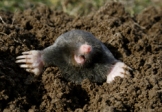What are moles?
Moles are relatives of shrews and hedgehogs, (insectivores); they are not rodents. They burrow in lawns, meadows, open woodlots, creating underground tunnels in search for  food. Their diet consists of earthworms, snails, centipedes, spiders, insect larvae, and other small creatures. Moles have long dark gray or brown fur, with pink feet and tails, and grow to about 4-9 inches long. Moles are keen diggers. Their front legs have multiple thumbs and broad claws; and snouts are shaped to assist in their desired dirt formations. There are currently seven species of moles in the United States.
food. Their diet consists of earthworms, snails, centipedes, spiders, insect larvae, and other small creatures. Moles have long dark gray or brown fur, with pink feet and tails, and grow to about 4-9 inches long. Moles are keen diggers. Their front legs have multiple thumbs and broad claws; and snouts are shaped to assist in their desired dirt formations. There are currently seven species of moles in the United States.
The two commonly encountered in Florida are the Eastern Moles and Star Nosed Moles.
What do mole hills look like?

Mole hills are circular and usually measure around 2 inches tall and can be up to a foot wide. They dig extensive networks of underground tunnels.Even though these animals mostly eat insects, landscaping and flower beds are at risk to significant damage with mole infestations.
Do moles bite?
Moles are not naturally aggressive. They have weak eyesight, and use other senses to keep  them from coming in contact with predators or humans. Human handling will make a mole feel threatened. This animal will fight to escape, often biting with sharp teeth. They are not normally carriers of the rabies virus, so normally a bite from this critter is not concerning. Standard side effects of a mole bite will include redness and swelling. Make sure that the laceration is cleaned and disinfected, and if the wound worsens over time seek medical attention.
them from coming in contact with predators or humans. Human handling will make a mole feel threatened. This animal will fight to escape, often biting with sharp teeth. They are not normally carriers of the rabies virus, so normally a bite from this critter is not concerning. Standard side effects of a mole bite will include redness and swelling. Make sure that the laceration is cleaned and disinfected, and if the wound worsens over time seek medical attention.
Do moles carry diseases?
Moles can pose health risks, and only in rare cases transmit rabies. The insect parasites that moles carry are more dangerous and likely pass from fleas or ticks to humans or pets. Ticks are hosts for diseases such as:
Lyme disease, Rocky Mountain spotted fever, anaplasmosis, and tularemia. Other parasitic organisms, like Bartonella and tapeworms, are the organisms that can pass to humans or pets. Avoid touching moles or any wild animals to avoid health hazards.
Even though moles mostly reside underground and the risk of spreading diseases is more rare than in other wildlife, their tunnel systems ruin landscaping and weaken the ground. Moles upturn grass and ruin gardens while constructing their dens. It is important to eliminate these pests before the tunnel systems become more extensive and destroy an entire yard.
If you think you might be a subject to mole damage, contact Affordable Wildlife Removal to schedule a full inspection.
